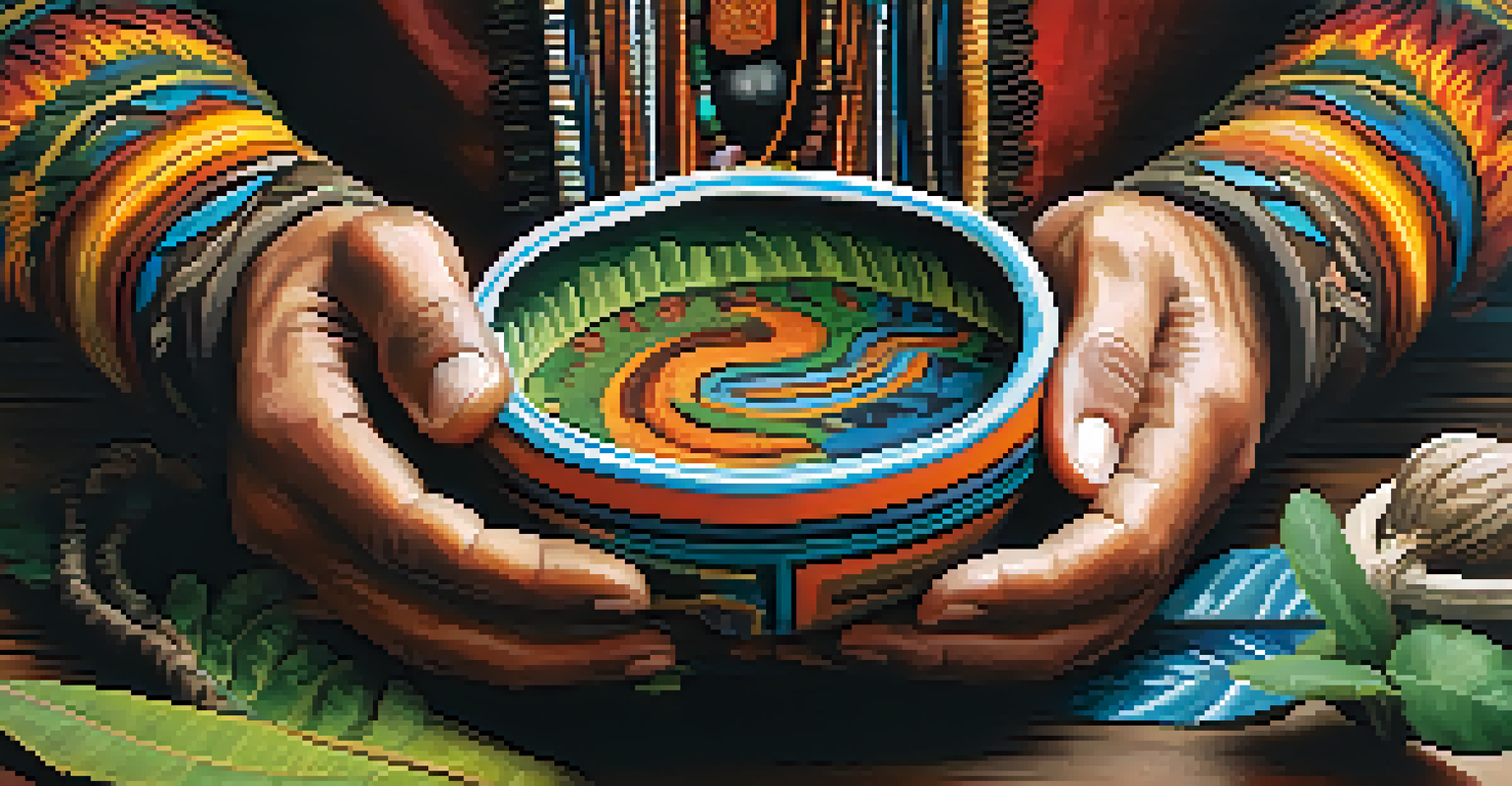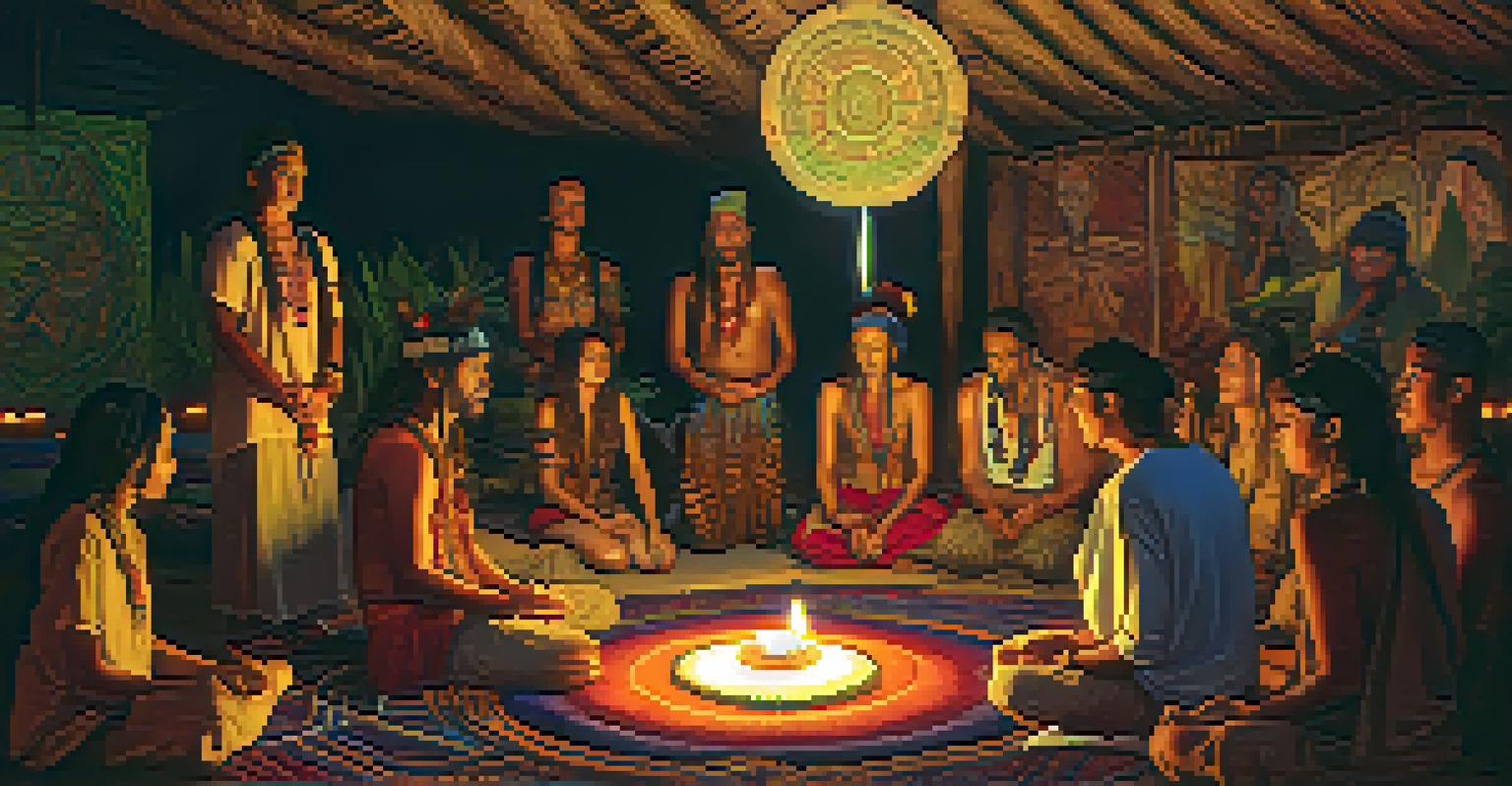Songs and Chants: The Shaman's Tool in Ayahuasca Healing

Understanding Ayahuasca and Its Healing Properties
Ayahuasca is a powerful plant medicine traditionally used in Amazonian cultures for spiritual and healing purposes. This brew, made from the Banisteriopsis caapi vine and other plants, can induce profound visions and emotional healing. Many people seek Ayahuasca ceremonies to confront personal traumas, gain insight, or connect with a deeper sense of self. The experience, however, is often guided by skilled shamans who play a pivotal role in the healing journey.
The song is a way for the shaman to connect with the spirit of the plant and create a healing environment for the participant.
The shaman's expertise extends beyond just administering the brew; they create an environment conducive to healing. This is where songs and chants come into play, serving as crucial tools during the ceremony. They are not merely entertainment; they are integral to the ritual and the healing process, helping to weave a safe and nurturing space for participants.
Understanding the significance of these songs and chants is essential for grasping how Ayahuasca works. They resonate at a spiritual level, helping participants navigate their inner landscapes. This unique blend of music and medicine enhances the transformative potential of the Ayahuasca experience.
The Role of the Shaman in Ayahuasca Ceremonies
In Ayahuasca ceremonies, the shaman acts as a guide, protector, and healer. With deep knowledge of the plants and the spiritual world, the shaman creates a connection between participants and the spirit of Ayahuasca. This relationship is crucial, as it helps participants feel safe and supported during intense experiences. The shaman's presence is often felt even before the ceremony begins, setting the tone for what’s to come.

One of the shaman's primary responsibilities during the ceremony is to lead with songs and chants known as 'icaros.' These are not just melodies; they are sacred songs that carry energetic vibrations intended to heal and guide. Each icaros is unique and can serve various purposes, such as calling on spirits, providing protection, or facilitating the release of negative emotions.
Ayahuasca's Healing Journey
Ayahuasca is used for spiritual and emotional healing, often guided by shamans to help participants confront personal traumas.
The shaman uses their intuition to select specific icaros that resonate with the collective energy of the participants. This deep connection transforms the healing experience, as the songs help to channel the Ayahuasca’s power, making the journey both personal and shared.
The Healing Power of Icaros
Icaros, the traditional songs used by shamans, are essential tools in the Ayahuasca healing process. These songs are believed to carry the spirit of the plants and the wisdom of the ancestors, creating a bridge between the physical and spiritual realms. Each icaros is imbued with intention, often reflecting the specific needs of the participants. For instance, a song might focus on healing grief, while another might promote courage or self-acceptance.
Music can heal the soul, and when combined with the wisdom of the ancestors, it becomes a powerful tool for transformation.
The power of icaro lies in its ability to evoke emotions and memories, guiding participants through their inner journeys. As the shaman sings, the vibrations resonate within the space, often eliciting strong emotional responses. This can lead to catharsis, allowing participants to confront and release deep-seated pain or trauma that may have been buried for years.
Moreover, the repetitive nature of these chants can create a trance-like state, helping participants to surrender to the experience. This surrender is crucial for healing, as it allows the Ayahuasca to work its magic more effectively, often resulting in profound realizations and transformations.
Cultural Significance of Songs and Chants
Songs and chants in Ayahuasca ceremonies are steeped in cultural significance, reflecting the rich traditions of Amazonian Indigenous peoples. These practices have been passed down through generations, embodying the spiritual and medicinal wisdom of the ancestors. The use of specific melodies and lyrics often varies among different tribes and shamans, showcasing the diversity of beliefs and practices surrounding Ayahuasca.
For the Indigenous communities, these songs are not just healing tools; they are a way to connect with their cultural identity and heritage. Participating in these rituals allows individuals to honor their ancestors and the natural world, reinforcing the importance of community and spirituality. This cultural context deepens the participants' experiences, making them feel part of something larger than themselves.
The Role of Icaros in Healing
Icaros, or sacred songs, are essential tools in Ayahuasca ceremonies, facilitating emotional release and enhancing the healing experience.
In a modern context, the blending of these ancient practices with contemporary therapeutic approaches highlights the universal quest for healing and connection. As more people turn to Ayahuasca for personal growth, understanding its cultural roots and respecting its traditions becomes increasingly important.
The Emotional Journey Through Songs and Chants
The emotional journey facilitated by songs and chants during Ayahuasca ceremonies is often transformative. As participants listen to the shaman's voice, they may find themselves swept away on a wave of memories and feelings, both joyful and painful. The power of music can unlock emotions that have long been suppressed, allowing for a cathartic release. This process can be uncomfortable at times, but it is also a vital part of healing.
Many participants describe the experience of feeling held and supported by the songs, as if the music is wrapping around them like a comforting embrace. This emotional support is crucial, especially during moments of vulnerability. The presence of the shaman, paired with the healing power of music, creates a safe space for individuals to confront their deepest fears and feelings.
Through this emotional journey, participants often emerge with a renewed sense of clarity and purpose. The songs serve as a reminder that they are not alone in their struggles; the collective experience of the group, guided by the shaman’s voice, fosters a sense of togetherness and healing.
Integrating the Experience After the Ceremony
The journey doesn’t end when the ceremony concludes; integration is a crucial part of the Ayahuasca experience. Participants often find themselves reflecting on the insights gained during the ceremony and how they can apply them to their daily lives. Songs and chants play a role in this integration process, as they can evoke the feelings and realizations that emerged during the ceremony. Listening to the same icaros outside of the ceremony can help reinforce these insights, creating a lasting connection to the experience.
Many individuals find it helpful to journal about their experiences, capturing the emotions and revelations that arose during the ceremony. This practice can deepen their understanding and facilitate healing as they process their journey. Sharing these experiences with trusted friends or support groups can also enhance the integration process, allowing participants to feel seen and heard.
Cultural Significance of Music
Songs and chants reflect the rich traditions of Amazonian Indigenous peoples, connecting participants to their cultural heritage and enhancing the healing process.
Ultimately, integrating the lessons learned through Ayahuasca and the accompanying songs and chants can lead to lasting change. It’s about transforming insights into actionable steps, helping individuals live more authentically and fully in their everyday lives.
The Future of Ayahuasca and Its Musical Traditions
As interest in Ayahuasca continues to grow worldwide, the future of its musical traditions is an important topic of discussion. With the influx of Western participants in ceremonies, there is a risk of cultural appropriation and dilution of the practices. It’s crucial to honor and respect the traditions of Indigenous shamans and communities, ensuring that their wisdom is preserved and shared appropriately. Engaging with these practices ethically means acknowledging their origins and the spiritual significance they hold.
At the same time, the blending of cultures can lead to beautiful new expressions of music and healing. Some shamans are open to incorporating diverse musical influences, creating a rich tapestry of sound that resonates with a broader audience. This evolution can enhance the Ayahuasca experience, providing a unique backdrop for healing journeys while still respecting the roots of the practice.

The future of Ayahuasca and its musical traditions is ultimately about balance—honoring the past while embracing the present. As more people seek healing and connection through these rituals, fostering an environment of respect and understanding will be key to ensuring that both the music and the medicine continue to thrive.